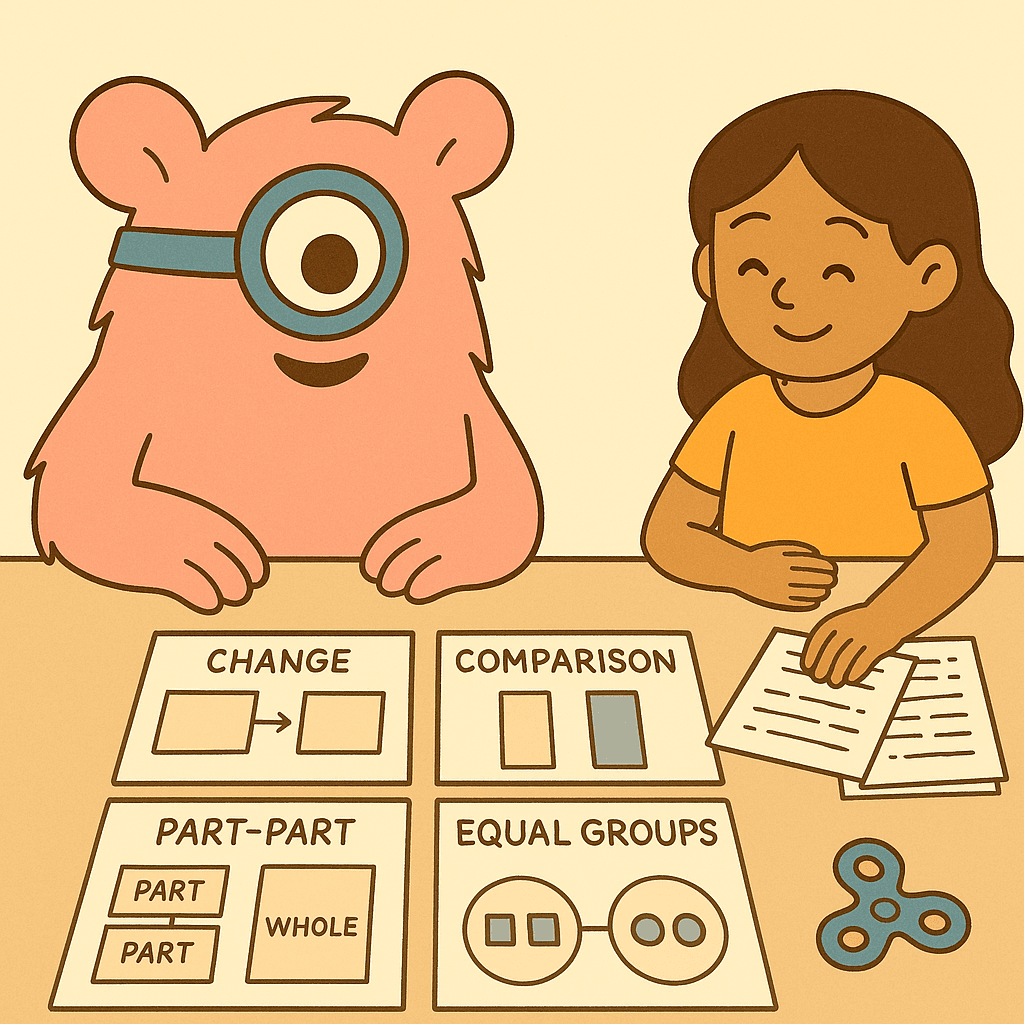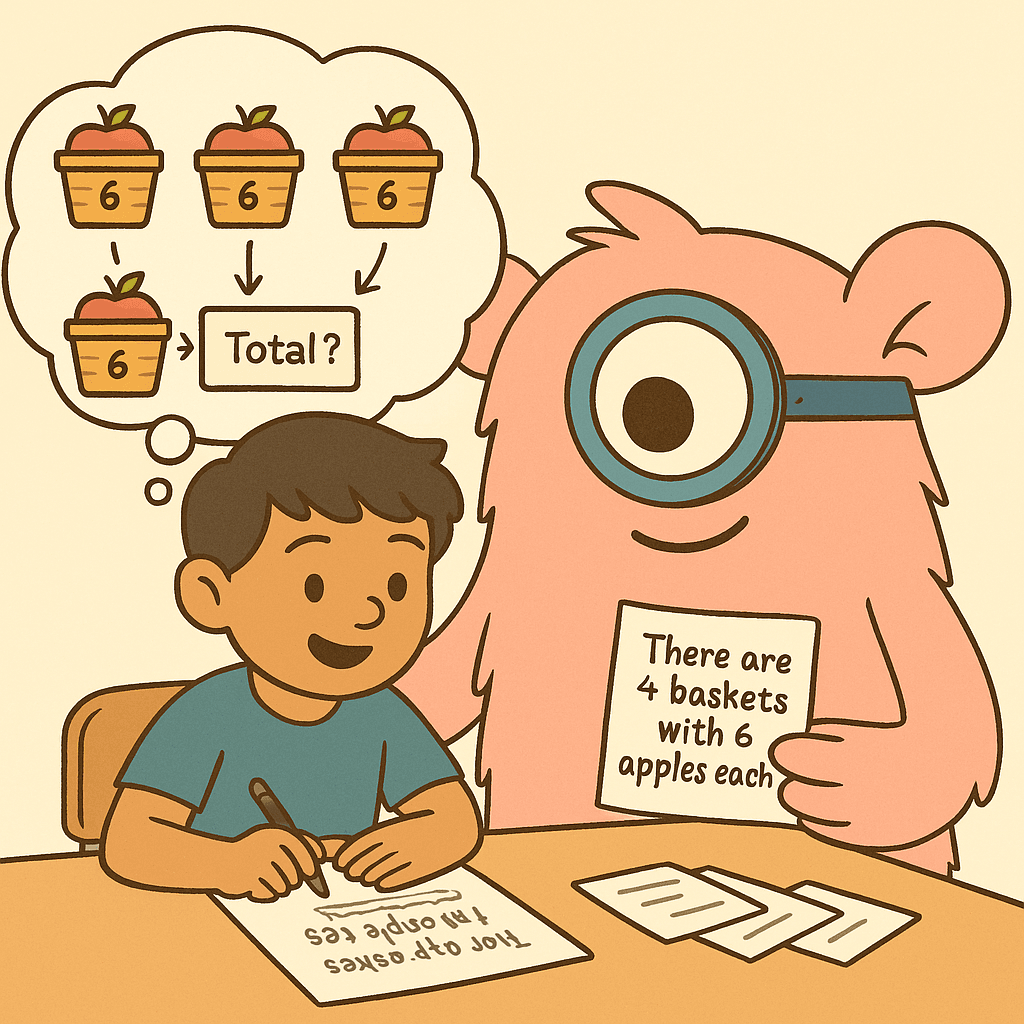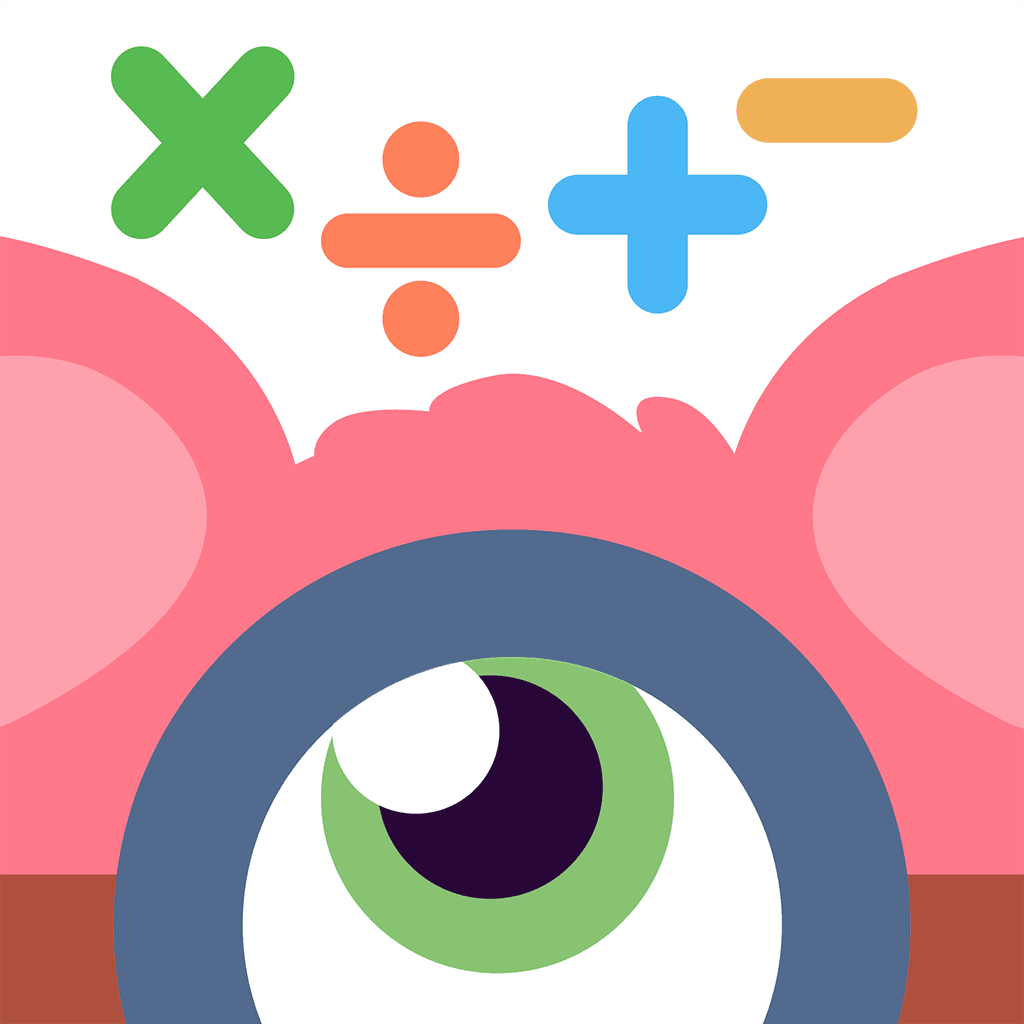How Knowing Problem Types Helps Solve Word Problems With Ease
TL;DR
Word problems often trip kids up not because of calculation, but because the story + language + relationships overload working memory. Teaching problem types (schemas) gives a repeatable playbook: spot the type → map it to a diagram → solve. For neurodivergent learners (ADHD, autism, dyscalculia), this structure reduces cognitive load and builds transfer to math facts and pre-algebra.
The Hidden Reason Kids Struggle with Word Problems
Imagine this: your child breezes through math facts drills, but the moment a story problem shows up “Sara has 8 apples, her friend gives her 5 more…” their shoulders tense and confidence crumbles. For many kids, especially those with ADHD, autism, or math learning differences, word problems feel like riddles wrapped in confusing language. It’s not the math facts that trip them up, it’s the storytelling. Research shows word-problem difficulty is driven by linguistic complexity interacting with numerical demands.
What if instead of treating every new problem as a mystery, we taught kids to spot familiar “types” of problems, like puzzles with predictable shapes? This shift can turn word problems from scary guesswork into solvable patterns.
Why Teaching “Problem Types” Works
It shrinks cognitive load, because, instead of starting from scratch each time, students map new stories onto a handful of templates (e.g., change, comparison, part–part–whole, equal groups). For elementary learners with math difficulties, schema-based instruction yields reliable gains in word-problem performance, with evidence spanning targeted reviews and classroom trials. A foundational review synthesizes how schema based metacognitive routine teaching helps students with or at risk for LD construct the right representation first, then compute.

The Core Word Problem Types Kids Need (with examples & how to teach)
Word problems may look endless, but beneath the surface they follow just a handful of recurring patterns. The key is to teach each type explicitly and guide kids through the same clear steps every time.
1) Change Problems (Start → Change → Result)
What it is: A quantity increases or decreases.
Visual organizer: Start–Change–Result (S-C-R) box or number line.
Language cues:gets, gives, more, fewer, left, after, before.
Example Problem:“Maya had 12 toy cars. She gave 5 to her friend. How many does she have now?”
Step by Step:Sort – Ask: “Did something change?” (Yes, she lost cars → Change type).
Highlight – Mark “start = 12,” “change = gave 5,” “result = ?”.
Map – Place on S–C–R diagram.
Plan – She gave away → subtract.
Compute – 12 − 5 = 7.
Check – Add back: 7 + 5 = 12.
Research note: Schema-based instruction reliably improves performance on these problems for students with difficulties.
2) Part–Part–Whole (Parts combine to a whole)
What it is: Two or more parts make a total.
Visual organizer: Part–Part–Whole bar model.
Language cues:in all, total, together, altogether.
Example Problem:“There are 8 red balloons and 6 blue balloons. How many balloons are there in all?”
Step by Step:
Sort – Ask: “Are these pieces of one thing?” (Yes, balloons).
Label – Red = 8, Blue = 6, Whole = ?.
Map – Fill diagram with two small boxes feeding into one big box.
Plan – Missing whole → add.
Compute – 8 + 6 = 14.
Check – Subtract to confirm: 14 − 8 = 6.
3) Comparison (How many more / fewer?)
What it is: Compare two amounts; unknown may be difference or missing amount.
Visual organizer: Comparison bar diagram (two bars, one longer).
Language cues:more than, fewer than, difference.
Example Problem:“Lila has 15 stickers. Max has 9 stickers. How many more stickers does Lila have?”
Step by Step:
Sort – “Are we comparing two amounts?” (Yes).
Draw – Two bars: Lila = 15, Max = 9.
Mark – The “gap” between 15 and 9 as the unknown.
Plan – Difference unknown → subtract.
Compute – 15 − 9 = 6.
Check – Max’s 9 + difference 6 = Lila’s 15.
Research note: Consistent diagrams tame the language load in comparison problems.
4) Equal Groups / Multiplicative Problems
What it is: Repeated groups, arrays, or “times as many.”
Visual organizer: Groups-of diagram or array.
Language cues:each, per, groups of, times as many.
Example Problem:“There are 4 baskets with 6 apples in each. How many apples are there in total?”

Step by Step:
Sort – Ask: “Do we have repeated groups?” (Yes, baskets).
Sketch – Draw 4 baskets × 6 apples each.
Label – Groups = 4, Size = 6, Total = ?.
Plan – Total unknown → multiply.
Compute – 4 × 6 = 24.
Check – Add groups: 6 + 6 + 6 + 6 =24.
Research note: Model-based instruction helps autistic learners succeed with multiplicative schemas.
5) Two-Step / Combination
What it is: Stories that combine two schemas (e.g., change + comparison).
Visual organizer: Stack two diagrams, or use sequential flow.
Language cues:then, after, difference, each.
Example Problem:“Sam had 20 candies. He ate 8. Then he shared the rest equally with 3 friends. How many candies did each friend get?”
Step by Step:
Sort – Step 1 = Change; Step 2 = Equal Groups.
Map 1 – Start 20, Change −8, Result = 12.
Map 2 – 12 candies ÷ 3 friends = ?.
Plan – Solve sequentially.
Compute – 20 − 8 = 12; 12 ÷ 3 = 4.
Check – 4 × 3 = 12 + 8 = 20 (matches original).
Research note: Schema instruction improves transfer to algebraic equation writing.
How to Teach Problem Types (short unit you can reuse)
- Introduce one type at a time (start with Change, Part–Whole).
- Use the same visual organizer every time. Graphic organizers benefit students with learning disabilities.
- Label quantities clearly.
- Practice sorting before solving. Schema-first routines boost accuracy and generalization.
- Solve inside the diagram, then compute.
- Fade supports gradually.
- Spiral old types into new practice.
Tips for Neurodivergent Learners
- Keep layouts predictable.
- Use checklists: “Type? Givens? Goal?” before computing.
- Break long problems into smaller chunks.
- Tie fact practice into schemas.
- Use tech as scaffolding. Technology-based supports show strong effects when they highlight structure and steps.
Conclusion
Word problems don’t have to be guesswork. Teaching problem types helps kids map stories into predictable patterns, lowering anxiety and building transfer to math facts and pre-algebra. For neurodivergent learners, this approach can mark the difference between panic and confidence.
FAQs
Q: What exactly are “problem types”?
They’re recurring structures (change, part–whole, comparison, equal groups, combo) kids can spot and diagram before computing. Teaching structure first is a proven way to improve outcomes.
Q: Why does this help neurodivergent kids?
Because it reduces the language and memory load while making the math relationships visible. Many neurodivergent learners (including those with ADHD, autism, or dyscalculia) struggle not with computation, but with holding story details, shifting between sentences, and interpreting tricky wording like “how many fewer”. Schema-based teaching removes the guesswork: instead of juggling text in working memory, kids slot the story into a familiar visual template (like a bar model or number line).
This predictability lowers anxiety, supports focus, and gives a clear path forward. For autistic learners especially, consistent visuals help bypass confusing language; for students with ADHD, the step-by-step structure acts like an external roadmap; and for dyscalculic learners, concrete diagrams bridge the gap from abstract symbols to meaningful representations. Studies show that these supports improve not just accuracy but also confidence and willingness to persist with harder problems. Visual models and explicit mapping improve accuracy.
Q: How should I start?
Begin with Change and Part–Whole, as they are most concrete and intutive, then add Comparison and Equal Groups
Kids already experience these daily: “I had 3 cookies, I ate 1” (Change), or “2 red blocks and 5 blue blocks make 7” (Part–Whole). These schemas map cleanly onto simple addition and subtraction and are easier to represent visually with number lines or part–whole bars.
Once students are fluent with those, introduce Comparison, which is trickier because of language complexity (“fewer than,” “how many more” often flips kids’ reasoning). Finally, add Equal Groups, which lays the foundation for multiplication and division and transitions naturally into pre-algebra.
References
- Fuchs, L. S., Gilbert, J. K., Fuchs, D., Seethaler, P. M., & Martin, B. N. (2018). Children’s mathematical development: Connecting language, schema, and working memory. Scientific Studies of Reading, 22(1), 92–106. https://pmc.ncbi.nlm.nih.gov/articles/PMC4381502/
- Jitendra, A. K., & Star, J. R. (2011). Meeting the needs of students with learning disabilities in inclusive mathematics classrooms: The role of schema-based instruction. Journal of Learning Disabilities, 44(6), 520–533. https://pmc.ncbi.nlm.nih.gov/articles/PMC6130842/
- Fuchs, L. S., Fuchs, D., Prentice, K., Hamlett, C. L., Finelli, R., Courey, S. J., & Phillips, N. B. (2003). Enhancing third-grade students’ mathematical problem solving with schema-based instruction. Journal of Educational Psychology, 95(2), 306–315. https://pmc.ncbi.nlm.nih.gov/articles/PMC2882678/
- Xin, Y. P. (2018). Conceptual model-based problem solving for students with autism spectrum disorder. Exceptionality, 26(4), 233–247. https://link.springer.com/article/10.1007/s11858-024-01568-w
- Dexter, D. D., & Hughes, C. A. (2011). Graphic organizers and students with learning disabilities: A meta-analysis. Learning Disability Quarterly, 34(1), 51–72. https://journals.sagepub.com/doi/10.1177/073194871103400104
- Jitendra, A. K., Harwell, M., Dupuis, D., & Karl, S. R. (2022). Technology-based word-problem interventions for students with disabilities: A meta-analysis. Journal of Special Education, 56(3), 167–180. https://www.mdpi.com/2227-7102/14/12/1372

